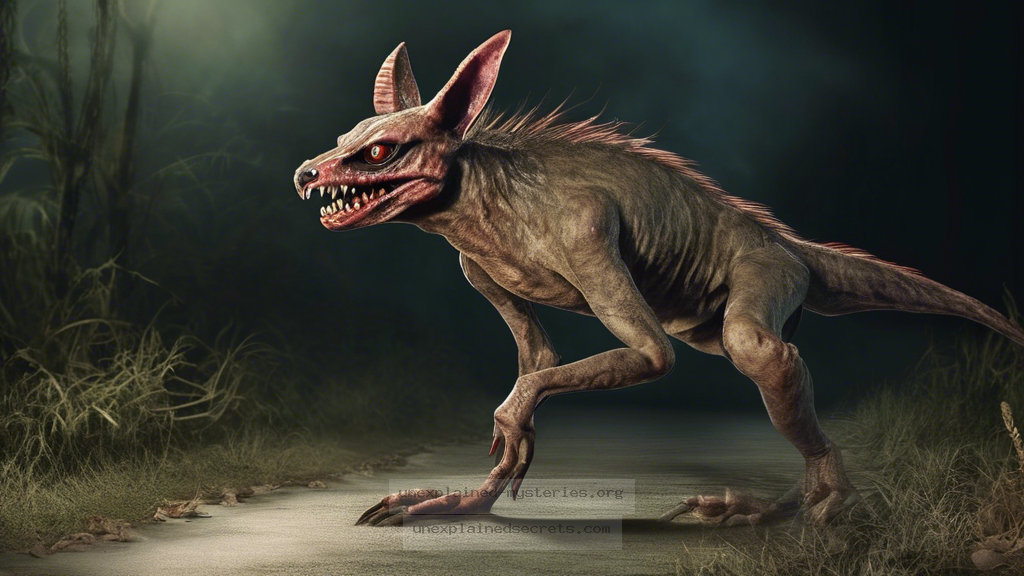Could the Chupacabra Be More Than Just a Myth? An In-Depth Investigation
Could the Chupacabra Be More Than Just a Myth? An In-Depth Investigation
The Chupacabra, a legendary creature often described as a blood-sucking beast, has captivated the imaginations of millions across the globe. But could this creature be more than just a figment of folklore? This question matters because understanding the origins and sightings of the Chupacabra can shed light on the broader field of Cryptozoology and our relationship with the unknown. This post will explore the historical context, core concepts, practical implications, alternative perspectives, and ongoing research related to this enigmatic creature.
The Origins of the Chupacabra Legend
The Chupacabra, which translates to “goat-sucker” in Spanish, first emerged in Puerto Rico in the 1990s. The legend began in 1995 when numerous livestock owners reported their goats being found dead, drained of blood with strange puncture wounds. The media quickly picked up the story, and the Chupacabra became an instant sensation. Witnesses described the creature as a small, reptilian being with sharp fangs and glowing eyes, often depicted as being about the size of a dog.
Over the years, the Chupacabra has evolved in terms of its appearance and behavior. While early reports painted a picture of a scaly, lizard-like creature, later sightings have described it as more canine in nature, resembling a hairless dog. This shift could indicate varying interpretations based on cultural contexts or even misidentified animals. However, the central mystery surrounding the Chupacabra remains: Is this creature a real biological entity, or simply a manifestation of human fears and imagination?
Core Concepts in Chupacabra Investigations
Cryptozoology, the study of animals whose existence has not been proven, plays a vital role in the investigation of the Chupacabra. Cryptozoologists employ various techniques to gather evidence, ranging from eyewitness accounts to physical specimens. The field often relies on a combination of folklore, biological research, and environmental studies to understand the potential existence of creatures like the Chupacabra.
One key aspect of this investigation is the analysis of sightings. Cryptozoologists categorize reports based on factors such as location, descriptions, and the conditions under which the sightings occurred. This data helps in identifying patterns that could lead to further investigations. Additionally, biological sampling of supposed Chupacabra remains has been conducted, often revealing that many “Chupacabras” are actually misidentified animals suffering from conditions such as mange.
Documented Cases of Chupacabra Sightings
Numerous sightings of the Chupacabra have been reported across the Americas, with notable cases in Puerto Rico, Texas, and even as far as Brazil. In 2005, in the town of Cuero, Texas, residents reported sightings of a strange creature that resembled a hairless dog. Local authorities investigated and concluded that the creature was likely a coyote infected with mange, yet many locals remained convinced it was the Chupacabra.
In 2010, a viral photo of a supposed Chupacabra in Texas reignited interest in the creature. The animal, captured by a local farmer, exhibited physical traits consistent with descriptions of the Chupacabra. Genetic testing later revealed it was a coyote with severe mange. Such cases highlight the role of sensationalism in shaping public perception and complicating the investigation of cryptids.
| Year | Location | Description | Outcome |
|---|---|---|---|
| 1995 | Puerto Rico | Small, reptilian creature draining goat blood | Widespread media coverage, legend begins |
| 2005 | Texas | Hairless dog-like creature | Identified as a coyote with mange |
| 2010 | Texas | Captured creature, viral photo | Confirmed as a coyote with mange |
Common Misconceptions About the Chupacabra
One major misconception about the Chupacabra is that it is universally accepted as a real creature by the scientific community. In reality, skepticism prevails among scientists who argue that there is insufficient evidence to conclusively prove the existence of the Chupacabra. Many believe that sightings can be attributed to misidentified animals, superstition, or even psychological phenomena.
Another misconception is the idea that all Chupacabra sightings match the original description of a reptilian creature. As previously mentioned, the descriptions have evolved, and not all sightings conform to the early reports. This variability suggests that the Chupacabra may be more reflective of cultural narratives than an actual biological species.
Practical Implications for Investigating Cryptids
Investigating cryptids like the Chupacabra has practical implications for wildlife management, public safety, and understanding human-animal interactions. Cryptozoologists often collaborate with biologists and ecologists to study the habitats and behaviors of reported sightings. This collaboration can lead to valuable insights into local ecosystems and animal populations.
For example, understanding the conditions that lead to livestock deaths can help farmers develop better management practices to protect their animals. Additionally, public education campaigns about recognizing local wildlife can reduce fear and misidentification of animals, thereby preventing unnecessary panic over supposed cryptid sightings.
Future Research Directions
The future of Chupacabra research will likely hinge on advances in genetic testing and ecological studies. As technology improves, researchers can analyze purported Chupacabra remains more effectively, potentially identifying genetic anomalies or diseases that could explain unusual behaviors in wildlife.
Furthermore, researchers may explore the psychological aspects of cryptid sightings, investigating why certain creatures gain traction in popular culture and how folklore shapes our understanding of the natural world. Such multidisciplinary approaches can enrich the field of Cryptozoology and provide deeper insights into the human experience with the unknown.
Alternative Perspectives on the Chupacabra
While many view the Chupacabra as a mythical creature, some theorists propose alternative explanations that blend folklore with social commentary. For example, some argue that the Chupacabra symbolizes fears about modern agriculture, globalization, and environmental degradation. In this sense, the creature becomes a metaphor for the consequences of human actions on nature.
Additionally, some cultural anthropologists suggest that the Chupacabra reflects the anxieties present in contemporary society, particularly in communities facing economic instability. The creature’s narrative resonates with those who feel powerless against larger forces, thus transforming the Chupacabra into a symbol of defiance and resilience.
Best Practices for Investigating Cryptids
For those interested in investigating reports of cryptids like the Chupacabra, here are some best practices to consider:
- Document Witness Accounts: Collect detailed statements from individuals who claim to have seen the creature, noting location, time, and environmental conditions.
- Engage with Local Experts: Collaborate with biologists and ecologists to gain insights into local wildlife and habitats.
- Use Technology: Employ tools such as camera traps and drones to gather evidence in the field without disturbing wildlife.
- Maintain Skepticism: Approach each sighting with a critical mindset, considering alternative explanations before jumping to conclusions.
- Educate the Community: Share knowledge about local fauna to reduce fear and misidentification of common animals.
Conclusion: The Chupacabra’s Place in Cryptozoology
The Chupacabra remains one of the most compelling mysteries within Cryptozoology, embodying a rich tapestry of folklore, cultural anxieties, and scientific inquiry. While many sightings can be attributed to misidentified animals or folklore, the ongoing fascination with the Chupacabra underscores our enduring curiosity about the unknown. As researchers continue to investigate, the Chupacabra serves as a reminder of the complex interplay between myth and reality, urging us to explore the depths of our understanding about the natural world and our place within it.
Other Articles
Recent Posts
- What Happened to Flight MH370? The Conspiracy Theories That Still Haunt Us
- What Secrets Lurk Within the Walls of the Infamous Trans-Allegheny Lunatic Asylum?
- What Evidence Supports the Existence of Bigfoot in the Pacific Northwest?
- What Happened to the Indus Valley Civilization? Unraveling the Mysteries of Ancient Urban Life
- Can Telepathy Be Scientifically Proven Through Laboratory Evidence?







